ASRock Rack C2750D4I Review: A Storage Motherboard with Management
by Ian Cutress on April 29, 2014 9:00 AM EST- Posted in
- Motherboards
- Storage
- Atom
- ASRock
- Silvermont
- Enterprise
- server
- Avoton
Real World CPU Benchmarks
Readers of our motherboard review section will have noted the trend in modern motherboards to implement a form of MultiCore Enhancement / Acceleration / Turbo (read our report here) on their motherboards. This does several things – better benchmark results at stock settings (not entirely needed if overclocking is an end-user goal), at the expense of heat and temperature, but also gives in essence an automatic overclock which may be against what the user wants. Our testing methodology is ‘out-of-the-box’, with the latest public BIOS installed and XMP enabled, and thus subject to the whims of this feature. It is ultimately up to the motherboard manufacturer to take this risk – and manufacturers taking risks in the setup is something they do on every product (think C-state settings, USB priority, DPC Latency / monitoring priority, memory subtimings at JEDEC). Processor speed change is part of that risk which is clearly visible, and ultimately if no overclocking is planned, some motherboards will affect how fast that shiny new processor goes and can be an important factor in the purchase.
For reference, the C2750D4I does not implement any form of MultiCore Turbo.
Additionally, we are currently testing other 25W platforms that might provide more of an apt comparison against the Avoton CPU. These will come in a future review when testing is complete.
Rendering – Adobe After Effects CS6: link
Published by Adobe, After Effects is a digital motion graphics, visual effects and compositing software package used in the post-production process of filmmaking and television production. For our benchmark we downloaded a common scene in use on the AE forums for benchmarks and placed it under our own circumstances for a repeatable benchmark. We generate 152 frames of the scene and present the time to do so based purely on CPU calculations.
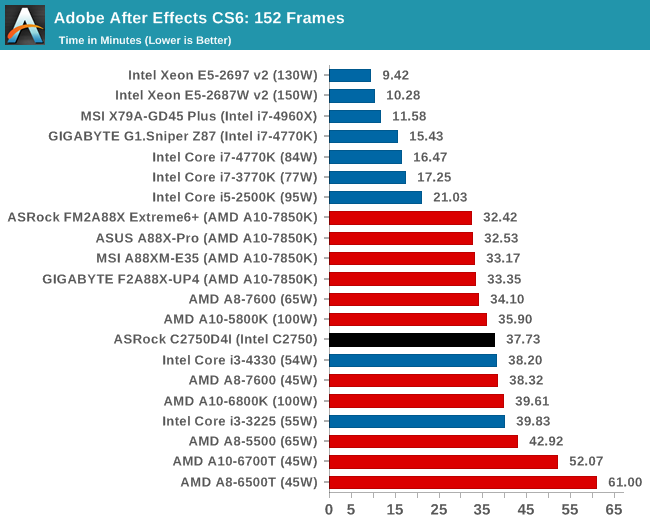
The full eight cores of the Avoton system gets to stretch its legs a little in our rendering test, easily putting it on par with the latest i3 CPUs and slightly behind the top end AMD APUs.
Compression – WinRAR 5.0.1: link
Our WinRAR test from 2013 is updated to the latest version of WinRAR at the start of 2014. We compress a set of 2867 files across 320 folders totaling 1.52 GB in size – 95% of these files are small typical website files, and the rest (90% of the size) are small 30 second 720p videos.
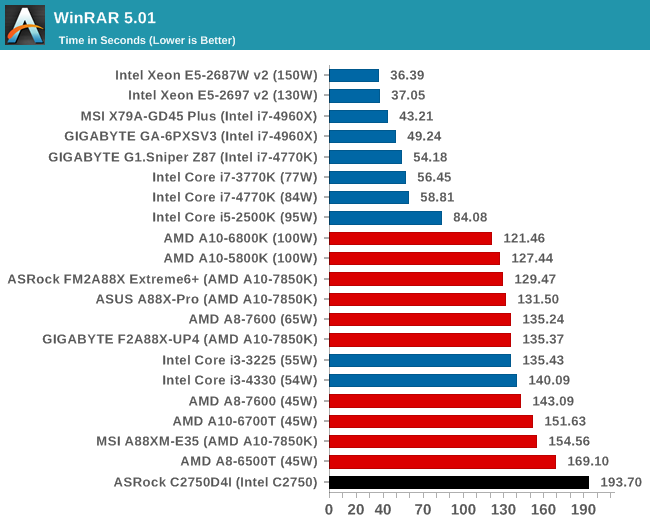
With a MHz deficit, the C2750D4I does not show much in the way of compression speed.
Image Manipulation – FastStone Image Viewer 4.9: link
Similarly to WinRAR, the FastStone test us updated for 2014 to the latest version. FastStone is the program I use to perform quick or bulk actions on images, such as resizing, adjusting for color and cropping. In our test we take a series of 170 images in various sizes and formats and convert them all into 640x480 .gif files, maintaining the aspect ratio. FastStone does not use multithreading for this test, and thus single threaded performance is often the winner.

Faststone is a purely singlethreaded benchmark, and the 2.6 GHz performance on Atom falls behind the main socketed platforms.
Video Conversion – Xilisoft Video Converter 7: link
The XVC test I normally do is updated to the full version of the software, and this time a different test as well. Here we take two different videos: a double UHD (3840x4320) clip of 10 minutes and a 640x266 DVD rip of a 2h20 film and convert both to iPod suitable formats. The reasoning here is simple – when frames are small enough to fit into memory, the algorithm has more chance to apply work between threads and process the video quicker. Results shown are in seconds and time taken to encode.
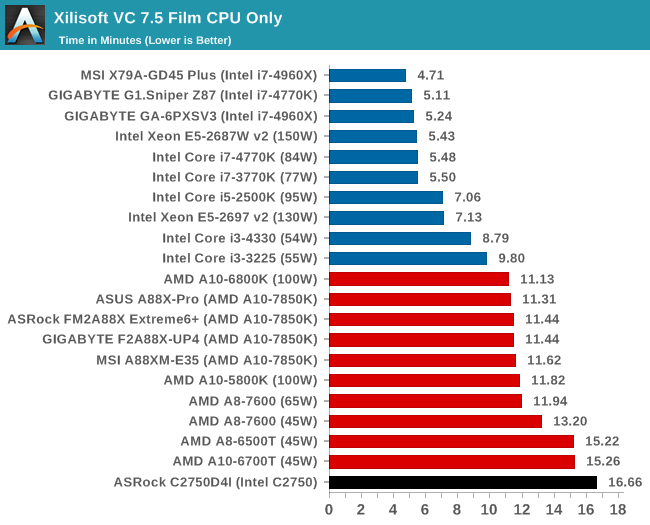
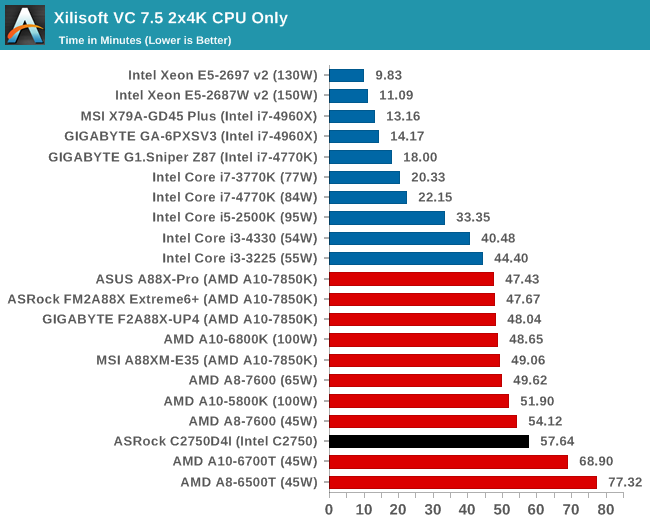
While the smaller frames cause the system to lag behind, the 4K video allows more cores to be put to better use.
Video Conversion – Handbrake v0.9.9: link
Handbrake is a media conversion tool that was initially designed to help DVD ISOs and Video CDs into more common video formats. The principle today is still the same, primarily as an output for H.264 + AAC/MP3 audio within an MKV container. In our test we use the same videos as in the Xilisoft test, and results are given in frames per second.
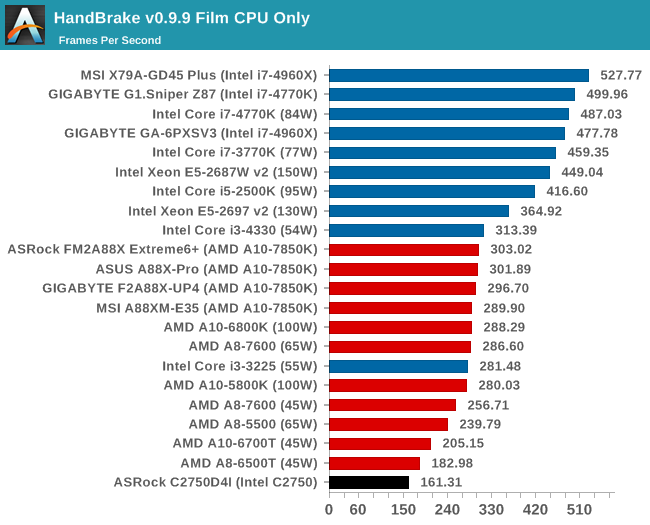
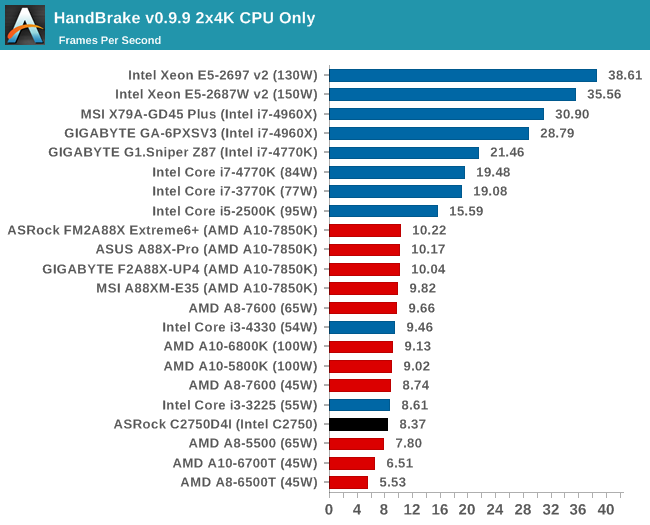
Similarly with HandBrake, the more cores benefit the higher resolution video conversion better.
Rendering – PovRay 3.7: link
The Persistence of Vision RayTracer, or PovRay, is a freeware package for as the name suggests, ray tracing. It is a pure renderer, rather than modeling software, but the latest beta version contains a handy benchmark for stressing all processing threads on a platform. We have been using this test in motherboard reviews to test memory stability at various CPU speeds to good effect – if it passes the test, the IMC in the CPU is stable for a given CPU speed. As a CPU test, it runs for approximately 2-3 minutes on high end platforms.
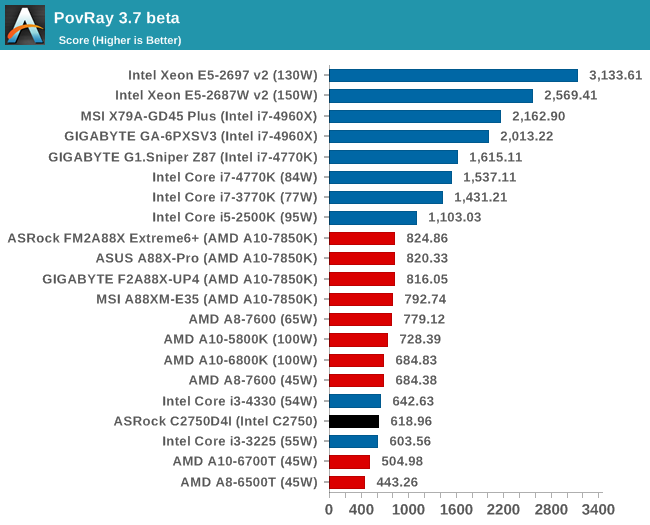










85 Comments
View All Comments
A5 - Tuesday, April 29, 2014 - link
For HTPC, I'd think you would probably want to get a small GPU for decode help anyway, so that would be where your audio comes from as well.bernstein - Tuesday, April 29, 2014 - link
yeah it's a shame this doesn't come with a hdmi connector... then i'd be sold. even though i wouldn't use any of the sata plugs and just hook a sas controller+expander up to it...hdmi + ecc + pcie x8 capability cpu+mobo for $400 would be a steal
slayernine - Tuesday, April 29, 2014 - link
QNAP's Intel Atom models have HDMI.bernstein - Tuesday, April 29, 2014 - link
yeah if only they had fanless 10+ bay models for less than $1000.bernstein - Tuesday, April 29, 2014 - link
oh and one that runs zfsGralgrathor - Thursday, May 21, 2015 - link
10+ disks without cooling? They won't last a day... And why would you need a hdmi-connector on a server mobo?DanNeely - Tuesday, April 29, 2014 - link
At $400 it's priced out of the core HTPC market; it's clearly intended as an entry level large storage server. As pointed out below, the spaghetti explosion from wiring a dozen drives with individual cables makes it unsuitable for most enterprise use (or prosumers who know better).Samus - Wednesday, April 30, 2014 - link
For $400 you could put together a better HTPC/NAS combo solution with an AMD AM1 ITX system and an Areca SAS RAID card in a PCIe slot. You'd get a superior onboard GPU with HDMI, native USB 3.0, and a better RAID card, not some Marvell crap.Athlon 5350 http://www.newegg.com/Product/Product.aspx?Item=N8...
ASUS AM1 ITX http://www.newegg.com/Product/Product.aspx?Item=N8...
Areca PCIe 8-port SAS http://www.newegg.com/Product/Product.aspx?Item=N8...
This motherboard is interesting and ASRock is a solid consumer OEM, but it's a little premature of them to be getting into rack space.
UpSpin - Wednesday, April 30, 2014 - link
You don't have to buy the overpriced octa core board, but could buy the identical quad core version ASRock C2550D4I for $280.http://www.newegg.com/Product/Product.aspx?Item=N8...
Your mainboard doesn't support ECC RAM and your SAS Controller only supports 8 SATA drives without further expanders. Together with the two SATA connectors on the mainboard you got only 10.
The quad core has an even lower TDP of 14W vs. 20W of the octa version. The C2750 has a faster CPU compared to your Athlon 5350.
The only disadvantage is the poor IGP. Considering that this is more a storage/server board, less a HTPC (who wants 12 noisy hard drives in the living room?) and the unbeatable price, it's a very interesting porduct in my opinion.
Samus - Friday, May 2, 2014 - link
Well, UpSpin, that would be why I said 'htpc/nas'If you purely want a NAS, there are probably better solutions than what I outlined, but for a hybrid (and who is to say the NAS wont be SSD's or 2.5" 2TB drives that are dead silent) this board, like Ian pointed out, is kind of a joke for an HTPC solution. It is VERY market specific, and virtually ALL AT readers aren't part of that market. This board is grossly overpriced, especially for something with ASRocks name on it. Even cold-storage servers should have USB 3.0 or eSATA. and quality products don't use some buggy $3.00 Marvell chipset that wipes arrays at random.